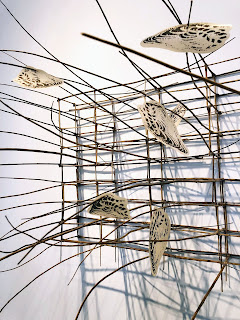Why were you interested in participating in the Look Here! pilot project?
Much of my work involves a dialectical overlay between physical experience and conceptual subtext. Whereas I may do extensive "needle-in-the-haystack" trolling of cultural context, history, politics to map my ideas, as an object maker I am still riveted by the rare, the firsthand experiencing of things. AGSL (The American Geographical Society Library) and the UWM Special Collections' rich, unique artifacts presented the possibility of adventure, exploring territories rarely visited and holding them to the light of now.
What collections are using or did you begin to use for your project?
Where I began as an explorer is not where we will arrive in the final work.
 My initial proposal was to use the Brumder and the Civil Rights collections to flesh out a children's book in progress - a primer on voting rights. Raking through the archives added a few important details to the project, which I will use, but my overall continuing research would lead me quite afield from the collections. Once Look Here! introduced us to the prospect of exhibiting at Villa Terrace, I felt the opportunity would better be used to connect to major ongoing threads within my studio work - the distribution of protectionist propaganda with migration/invasion of plant and wildlife - to the research opportunity.
My initial proposal was to use the Brumder and the Civil Rights collections to flesh out a children's book in progress - a primer on voting rights. Raking through the archives added a few important details to the project, which I will use, but my overall continuing research would lead me quite afield from the collections. Once Look Here! introduced us to the prospect of exhibiting at Villa Terrace, I felt the opportunity would better be used to connect to major ongoing threads within my studio work - the distribution of protectionist propaganda with migration/invasion of plant and wildlife - to the research opportunity.The Brumder publishing collection with its emphasis on familiarizing and situating the 19th century, immigrant German population in their new locale, Milwaukee, once gave a widely needed framework of belonging, influence and assumed regional values. I looked at far more than I could ever use but settled on Our native birds of song and beauty by H. Nehring.
Casting a wide net helped me gather a bounty which I can winnow - eliminating this option or that, focusing to a multi-layered simplicity; considering whether what I envision has been done or not, giving authentic context for my effort and finally being reassured that I am pursuing a new path.
 |
| Zuber Gallery at Villa Terrace |
Since the Zuber room is centered to overlook an Italian inspired garden, I expanded into meanings of garden design - The Art of Garden Design in Italy by H. Inigo Triggs and ASGL photographs of the Gardens of Babur in Kabul (Bagh-e Babur). Destroyed in war this Islamic garden was built along a center stepped spine of water in the 1500s as a reminder of paradise and became an influence on Renaissance thought.
How did what you found in the collections influence your work?
Because I have strong trajectories in my practice, I worked to connect the collection to what I am doing, rather than approaching without a concept looking for inspiration. This means a much longer process of research to find what resonates, what deepens through threads of connections over time. I admit this has been sometimes a struggle with optimistic starts that did not pan out, but the librarians were always excited to suggest, "Have you seen this?" or "Maybe you would find this valuable." Their guidance has been the most valuable asset.
How does having so much content available digitally affect the work you're creating? Or does it?
 I began my research with an exhibition on Brumder Publishing and the actual artifacts. Special Collections offered to digitize any holdings, and scanning Nehring's Birds became a foundation for my project. Perhaps the biggest advantage was in culling through the online catalogue of holdings and seeing images there that opened up new avenues of research.
I began my research with an exhibition on Brumder Publishing and the actual artifacts. Special Collections offered to digitize any holdings, and scanning Nehring's Birds became a foundation for my project. Perhaps the biggest advantage was in culling through the online catalogue of holdings and seeing images there that opened up new avenues of research.The high quality of the images meant that I could work directly with information rich files. To pry open the singularity of one-of-a-kind artifacts, books, engravings, to share them broadly. And yet, my work - despite digitally laser cutting woodblocks and several hundred prints - will be synthesized into a fragile, temporary, first-hand physical nature of a site-specific installation. The expansion and contraction of experience is the irony of our digital age.
What more can you tell us about your experience in this project?
Knowing that the work from Look Here! would be shared in an exhibition in a venue, Villa Terrace, laden with rich history impacted the direction of my project.
We romanticize nature, and we idealize it in gardens. Right in front of us on a micro level are ongoing lessons of life and death, war and peace, heaven and hell found by closely considering a small plot of earth.
The Zuber Room at the Villa Terrace is papered with handprinted scenes of an exotic Chinoise paradise. My site-specific installation will inject realities of the garden world outside where drab Wisconsin Sparrows have been harvested for culinary pleasure; Red Wing Blackbirds fiercely defend their territory; Tree of Heaven Sumac, Wild Mustard, Burdock and Thistle invade, threatening the order of a perfect world; and where the continuing war in Afganistan seems remote, unreal.
======
More about Jill Sebastian's work is here: http://jillsebastian.com/

No comments:
Post a Comment